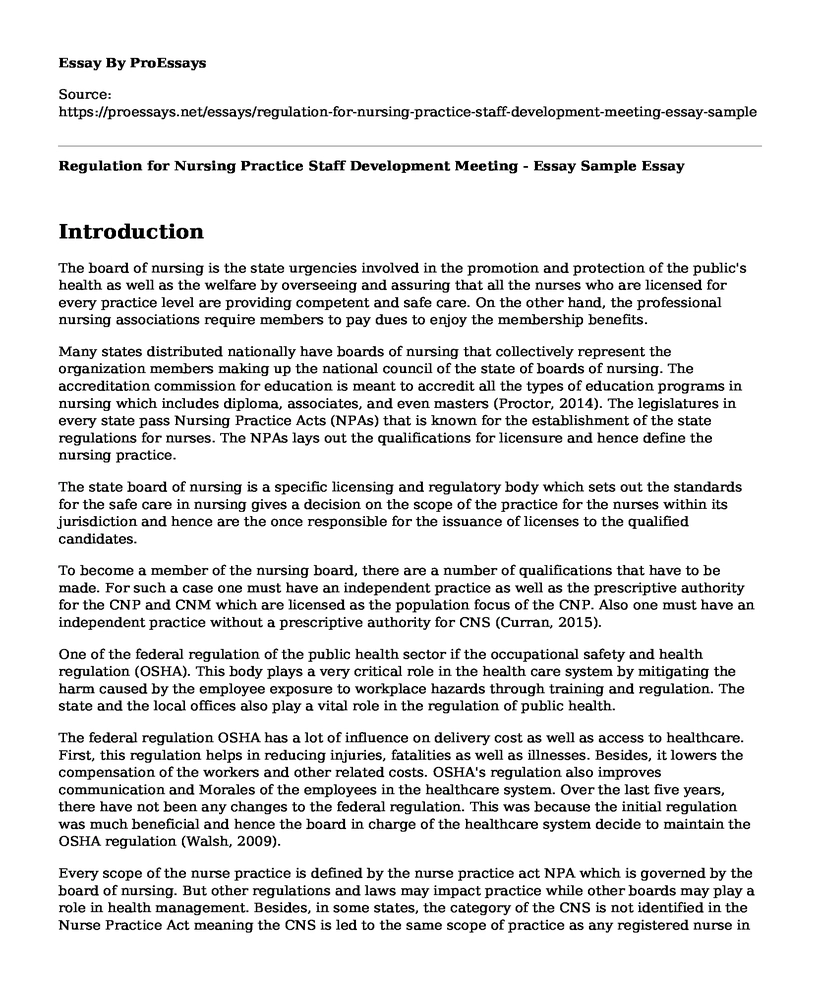Introduction
The board of nursing is the state urgencies involved in the promotion and protection of the public's health as well as the welfare by overseeing and assuring that all the nurses who are licensed for every practice level are providing competent and safe care. On the other hand, the professional nursing associations require members to pay dues to enjoy the membership benefits.
Many states distributed nationally have boards of nursing that collectively represent the organization members making up the national council of the state of boards of nursing. The accreditation commission for education is meant to accredit all the types of education programs in nursing which includes diploma, associates, and even masters (Proctor, 2014). The legislatures in every state pass Nursing Practice Acts (NPAs) that is known for the establishment of the state regulations for nurses. The NPAs lays out the qualifications for licensure and hence define the nursing practice.
The state board of nursing is a specific licensing and regulatory body which sets out the standards for the safe care in nursing gives a decision on the scope of the practice for the nurses within its jurisdiction and hence are the once responsible for the issuance of licenses to the qualified candidates.
To become a member of the nursing board, there are a number of qualifications that have to be made. For such a case one must have an independent practice as well as the prescriptive authority for the CNP and CNM which are licensed as the population focus of the CNP. Also one must have an independent practice without a prescriptive authority for CNS (Curran, 2015).
One of the federal regulation of the public health sector if the occupational safety and health regulation (OSHA). This body plays a very critical role in the health care system by mitigating the harm caused by the employee exposure to workplace hazards through training and regulation. The state and the local offices also play a vital role in the regulation of public health.
The federal regulation OSHA has a lot of influence on delivery cost as well as access to healthcare. First, this regulation helps in reducing injuries, fatalities as well as illnesses. Besides, it lowers the compensation of the workers and other related costs. OSHA's regulation also improves communication and Morales of the employees in the healthcare system. Over the last five years, there have not been any changes to the federal regulation. This was because the initial regulation was much beneficial and hence the board in charge of the healthcare system decide to maintain the OSHA regulation (Walsh, 2009).
Every scope of the nurse practice is defined by the nurse practice act NPA which is governed by the board of nursing. But other regulations and laws may impact practice while other boards may play a role in health management. Besides, in some states, the category of the CNS is not identified in the Nurse Practice Act meaning the CNS is led to the same scope of practice as any registered nurse in the state. This influences the role of a nurse in the perfection of his/her own skills .through practice the nurses can carry out their duties best hence improving on the healthcare (Russell, 2012). This regulation reduces healthcare cost and simplifies healthcare access.
Given the variation between the Advanced Practice Registered Nurses (APRNs) and the related statutes, rules and regulations of a given state, it is important that the APRNs have a clear understanding of the way in which their scope of practice is defined by the laws and regulations and also the views promulgated by the states regulatory agency. The regulation also helps in guiding nurses to work effectively and perfectly in the line of duties as professionals in healthcare. The regulation as well has a positive influence on the delivery access to the health care and also cost, just and in the case of the federal regulation
References
Proctor, S. T. (2014). School Nursing Practice: Roles and Standards.
Nagelkerk, J. (2005). Leadership and nursing care management. Elsevier Health Sciences.
Curran, C. (2015). Nurse on board: Planning your path to the boardroom. Sigma Theta Tau.
Walsh, D. C., & Egdahl, R. H. (2009). Payer, provider, consumer: industry confronts health care costs. New York: Springer-Verlag.
Russell, K. A. (2012). Nurse practice acts guide and govern nursing practice. Journal of Nursing Regulation, 3(3), 36-42.
Cite this page
Regulation for Nursing Practice Staff Development Meeting - Essay Sample. (2022, Dec 19). Retrieved from https://proessays.net/essays/regulation-for-nursing-practice-staff-development-meeting-essay-sample
If you are the original author of this essay and no longer wish to have it published on the ProEssays website, please click below to request its removal:
- Research Paper on Family Nursing Practice
- How the Technology Will Achieve the Public Health Goals Paper Example
- Essay Example on Nurse Practitioners: Promoting Good Health, Prevention & Better Care Outcomes
- Essay on Hypoesthesia: Reduced Sensory Sensation & Paraesthesia Effects
- A Comparative Study of Saudi Students' Self-Practice Habits and Oral Health
- Leadership Nursing: Creating Positive Change in Healthcare - Research Paper
- Advantages and Disadvantages of Plastic Surgery - Essay Sample







